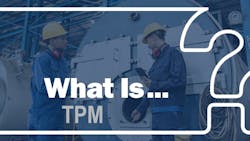Key Highlights
- Total Productive Maintenance (TPM) involves all employees in proactive maintenance, focusing on eight pillars to maximize equipment effectiveness and reduce costs.
- ISO 14001 certification helps manufacturers improve sustainability, manage resources efficiently, and build stakeholder confidence through standardized practices.
- Emerging trends include digitalization, integration with Lean and Six Sigma, and fostering a culture of continuous improvement to enhance maintenance and environmental strategies.
Maintenance has evolved significantly over the years, from a reactive, break-fix approach to a proactive, predictive strategy aimed at maximizing equipment uptime and efficiency. One key trend in this evolution is Total Productive Maintenance (TPM), a holistic approach that involves the entire organization in the pursuit of maintenance excellence. This article briefly outlines the principles of TPM and its benefits, and explores how organizations are embracing this trend to achieve operational excellence.
What are the goals of Total Productive Maintenance (TPM)?
TPM is a comprehensive maintenance strategy that aims to maximize the effectiveness of equipment through the involvement of all stakeholders, including operators, maintenance personnel, and management. TPM is based on the beliefs that (1) everyone in the organization is responsible for maintenance, and (2) equipment effectiveness is critical to overall business success.
What are the pillars of TPM?
TPM is built on eight pillars, each representing a key aspect of the maintenance process:
- Autonomous Maintenance: Operators are trained to perform routine maintenance tasks, such as cleaning, inspection, and lubrication, to prevent equipment deterioration.
- Planned Maintenance: Maintenance activities are scheduled based on equipment condition and production requirements, rather than waiting for failures to occur.
- Focused Improvement: Continuous improvement teams identify and eliminate losses and inefficiencies in the production process to improve overall equipment effectiveness (OEE).
- Early Equipment Management: New equipment is designed and installed with a focus on maintainability and reliability, ensuring long-term effectiveness.
- Quality Maintenance: Maintenance activities are aimed at preventing defects and ensuring that equipment meets quality standards.
- Training and Education: Operators and maintenance personnel are trained to understand and perform their roles effectively, contributing to overall equipment effectiveness.
- Administrative and Office TPM: Extends the principles of TPM to administrative and office processes, improving overall efficiency and effectiveness.
- Safety, Health, and Environment: TPM emphasizes the importance of maintaining a safe and healthy work environment, as well as minimizing the environmental impact of operations.
What are the benefits of TPM?
Implementing TPM can lead to a wide range of benefits for organizations, including:
- Increased Equipment Availability: By reducing breakdowns and downtime, TPM improves equipment availability, allowing for more efficient production.
- Improved Productivity: TPM optimizes equipment performance, leading to increased productivity and throughput.
- Reduced Costs: By preventing breakdowns and focusing on proactive maintenance, TPM can lower maintenance costs and reduce the need for spare parts.
- Enhanced Quality: TPM's focus on preventing defects and maintaining equipment can lead to improved product quality and customer satisfaction.
- Engaged Workforce: Involving all employees in the maintenance process can lead to a more engaged and empowered workforce, driving continuous improvement.
How can my team embrace TPM trends?
Organizations are increasingly recognizing the value of TPM and are embracing several key trends to enhance its effectiveness:
- Digitalization: Using digital tools and technologies, such as IoT sensors and predictive analytics, to monitor equipment condition and performance in real-time.
- Integration with Lean and Six Sigma: Combining TPM with Lean and Six Sigma principles to further improve efficiency and eliminate waste.
- Focus on Cultural Change: Emphasizing the importance of a culture of continuous improvement and employee engagement in TPM implementation.
- Supplier Involvement: Involving suppliers in the TPM process to ensure that equipment and parts meet TPM standards.
Conclusion
Total Productive Maintenance represents a paradigm shift in maintenance philosophy, emphasizing the importance of proactive, holistic maintenance practices. By focusing on the eight pillars of TPM and embracing the latest trends, organizations can achieve higher levels of equipment effectiveness, productivity, and overall operational excellence. As TPM continues to evolve, organizations that embrace its principles are likely to gain a competitive advantage in today's dynamic business environment.
About the Author
Joe Anderson
Joe Anderson is a partner and chief operating officer for ReliabilityX. Joe helps companies reach their full potential through improvement gains and lowering costs, giving them a competitive advantage on their journey to excellence. As an active columnist in Plant Services magazine, Joe shares his over 25 years of experience in maintenance, reliability and management excellence in various industries with the world through his writing. He is a CMRP, CRL, CARO, MLT2, MLA1, LSSGB, IAM-55k, CRL Black Belt and was recognized as one of the top 50 leaders in the country by the United States Congress, being awarded the National Leadership Award. He has also brought humor to the world through his experiences, and it can be seen in the character creation of Captain Unreliability.
